This simple Lebanese Fattoush salad combines baked or pan-fried pita bread with fresh salad vegetables and a flavor-packed, zesty lemon and pomegranate molasses dressing. The resulting Middle-Eastern salad is perfect for serving as a light lunch or dinner, is dairy-free, and can easily be made gluten-free!
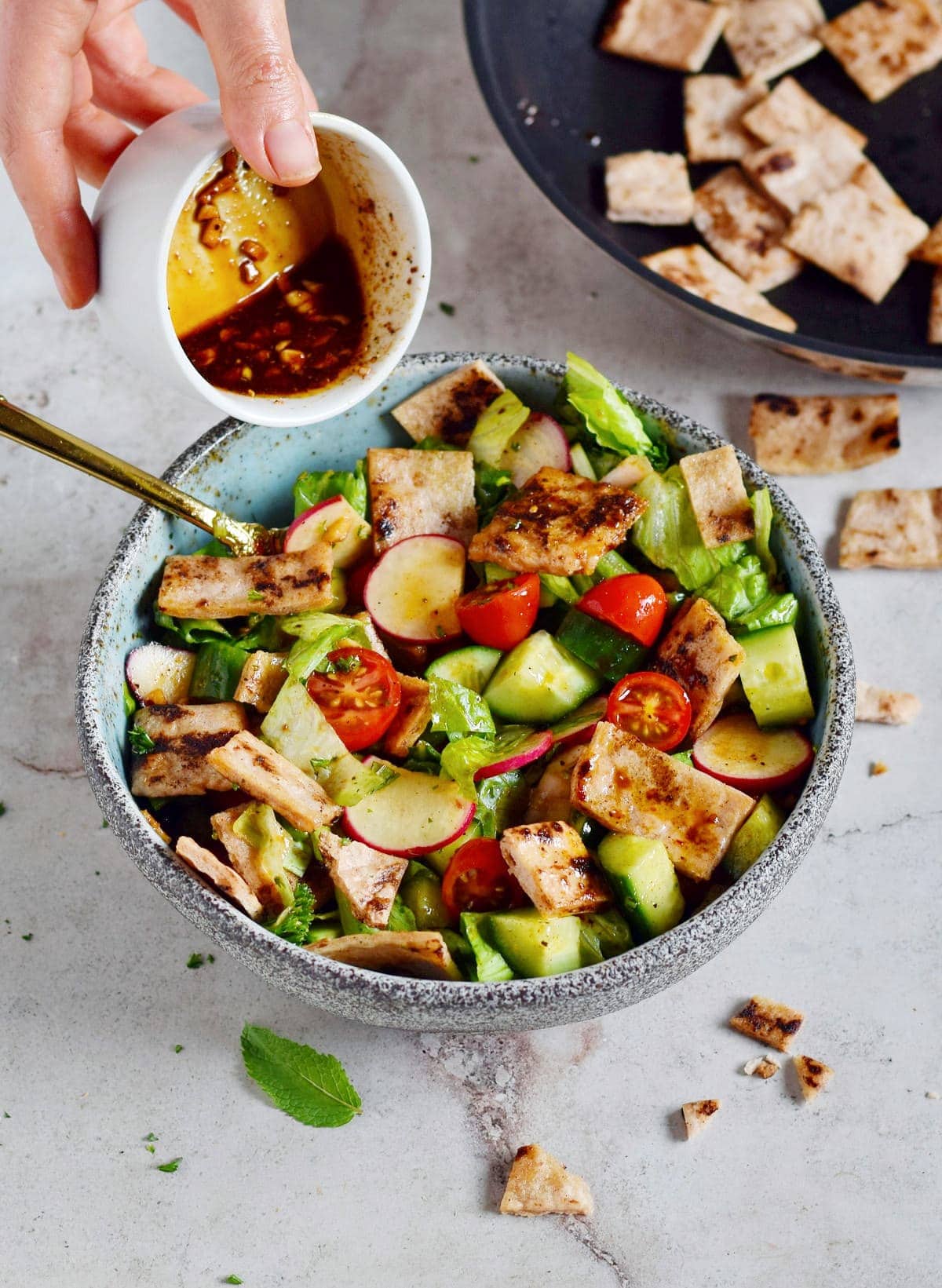
When it comes to enjoying International cuisine, I love enjoying food from all over the globe. Tantanmen ramen from Japan, eggplant curry from India, bruschetta from Italy, gluten-free French bread, and now this Lebanese Fattoush salad.
This bread salad is simple to make, fresh, crunchy, and packed with flavor. Even better, it’s easy to adapt, can be made with gluten-free pita, and can be adjusted in several ways – perfect for clearing out your crisper drawers. That’s just my kind of dish!

What is Fattoush?
Fattoush salad (also spelled Fatoush and Fatoosh) is a type of Levantine salad created to use up leftover, stale pita bread. The pita bread is traditionally fried until crispy, providing flavor and texture.
When combined with mixed greens and vegetables (usually lettuce, tomatoes, cucumber, and radish- though many combinations exist), it creates a crunchy, fresh salad that is combined with a simple yet tasty olive oil-based dressing and often contains sumac.
This Fattoush recipe remains fairly loyal to the original, yet I decided to use gluten-free pita, created methods by baking or pan-frying the pita, and spent some time tweaking the dressing to my liking.
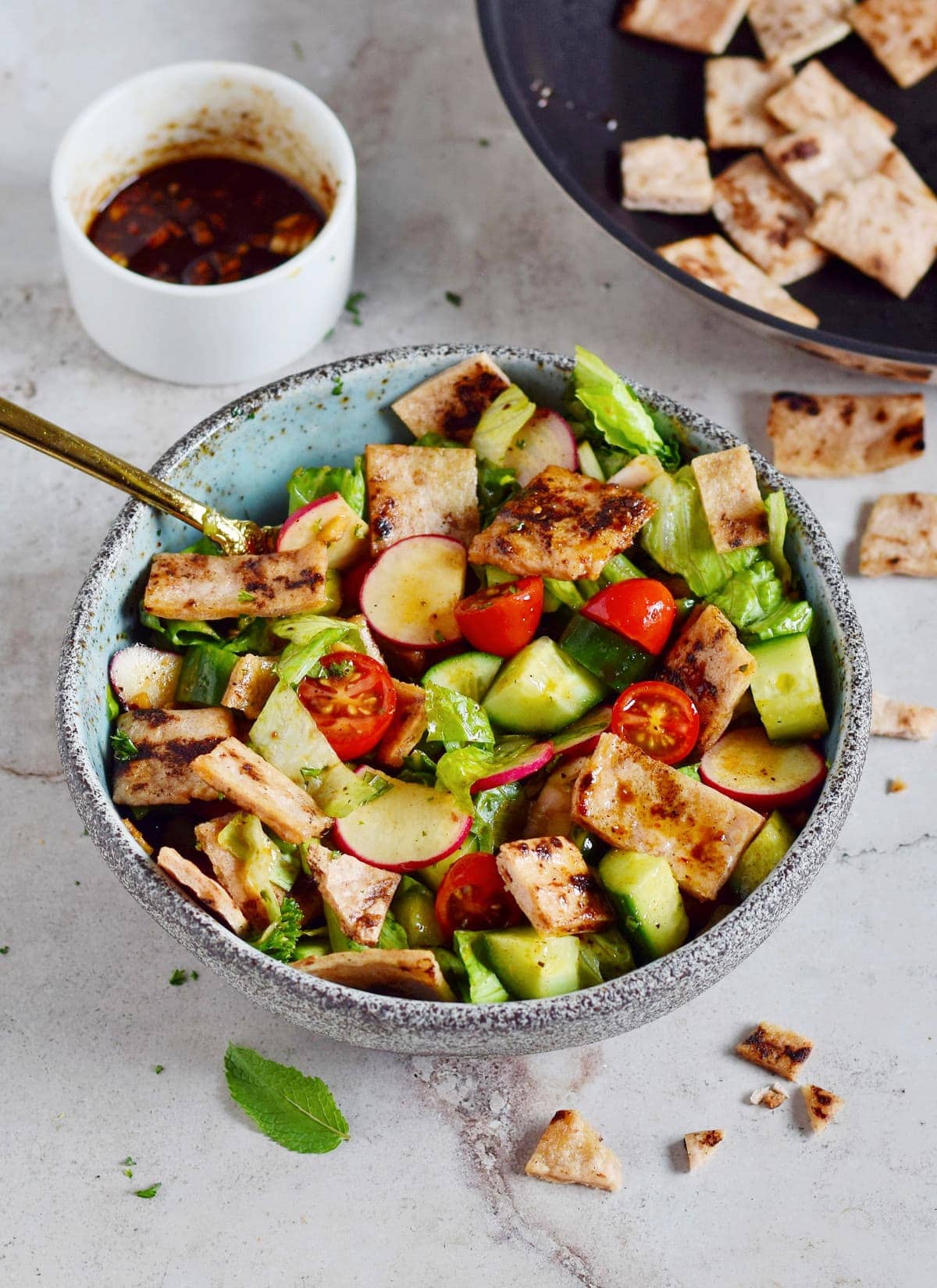
The Ingredients and Substitutions
The Bread Salad
- Pita bread: I used homemade gluten-free pita; feel free to use the pita of your choice. If you’re able to, then find some authentic Middle-Eastern-style pita bread for the most authentic results.
- Lettuce: Romaine lettuce is my preferred choice, though you could also use iceberg lettuce.
- Tomatoes: I used cherry tomatoes, halved. You could use larger tomatoes, though, like Roma tomatoes (chopped into small pieces).
- Cucumbers: Persian cucumber is the best for this recipe; they’re small and not too watery/seedy. However, any cucumber will work.
- Radish: These are subtle, with a slightly peppery flavor and a wonderful addition to the fattoush salad.
- Green onion: I like the subtle mellow flavor of the green onion. However, you could add white or red onions if preferred. If you want to mellow the flavor, allow them to sit in the lemon juice for a while before serving.
- Herbs: I use a combination of fresh chopped parsley and mint. If you’re not a fan of mint, then feel free to omit it- though I think it packs in tons of flavor.
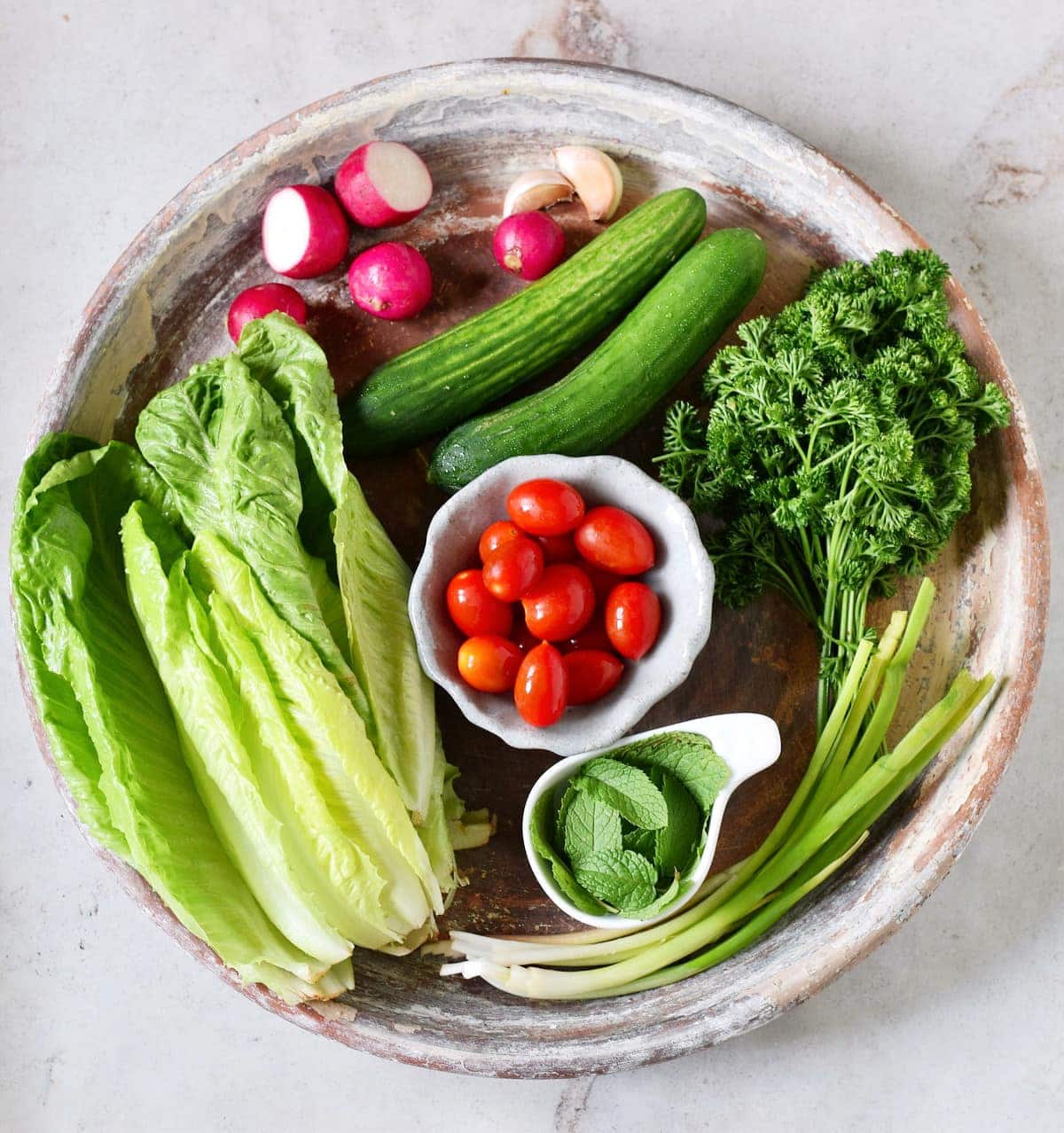
The Fattoush Dressing
- Olive Oil: Use high-quality olive oil for the best flavor. I recommend using extra virgin olive oil.
- Lemon juice: Make sure to use fresh lemon juice for the best flavor.
- Pomegranate molasses: This adds a lovely sweet/tangy flavor but can be substituted with balsamic or regular molasses if you cannot find pomegranate molasses. Just note that the flavor will differ.
- Garlic: Feel free to adjust the amount to personal preference
- Spices: I used a combination of salt, pepper, and sumac (popular in Arab food – adjust amounts to personal preference).
For the full ingredients list, measurements, complete recipe method, and nutritional information please read the recipe card below.
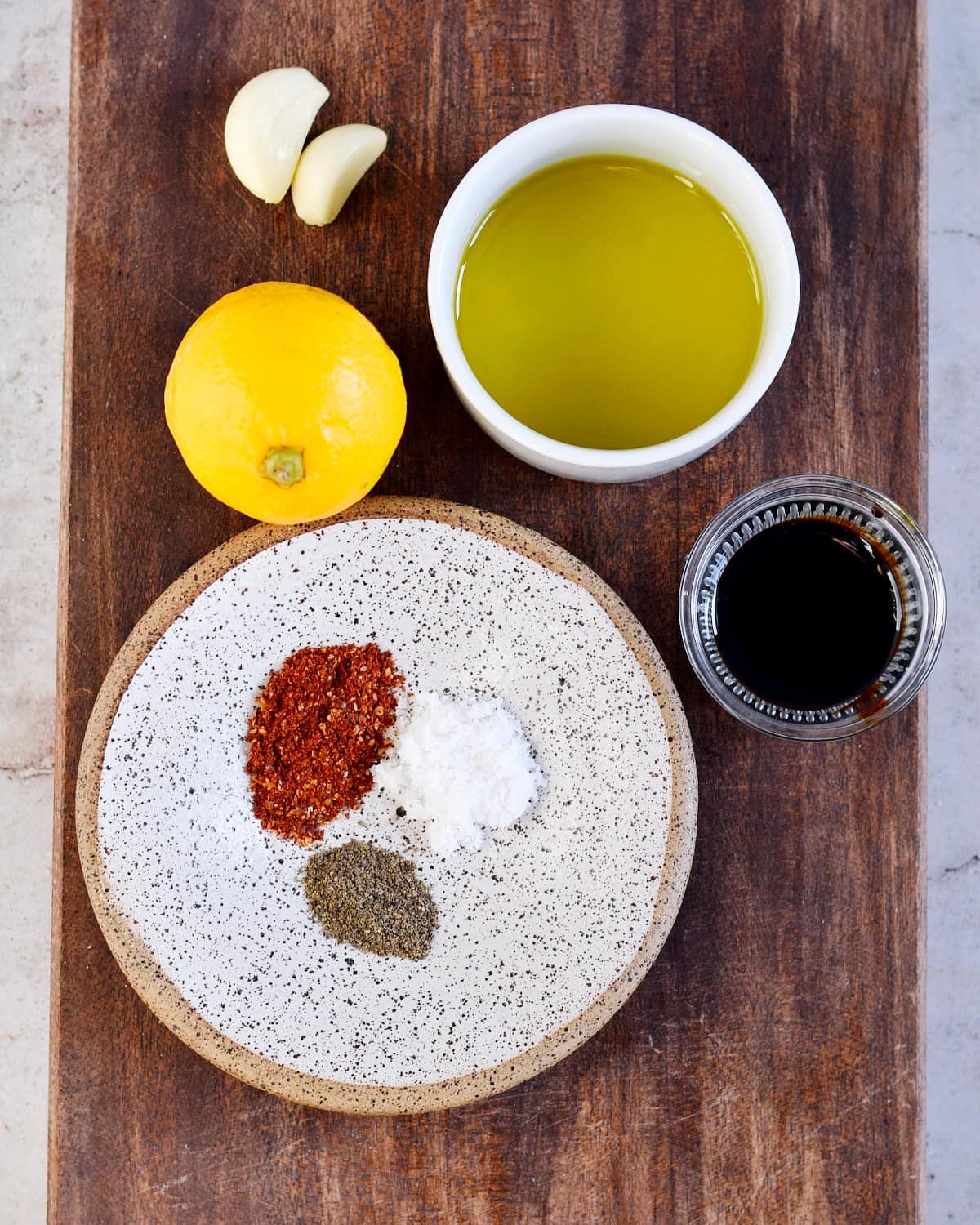
How to Make Fattoush Salad
- First, preheat the oven to 390F/200C.
- Then, chop the pita into small bite-sized pieces. Brush them with a bit of oil (or add to a bowl and drizzle with oil, then toss).
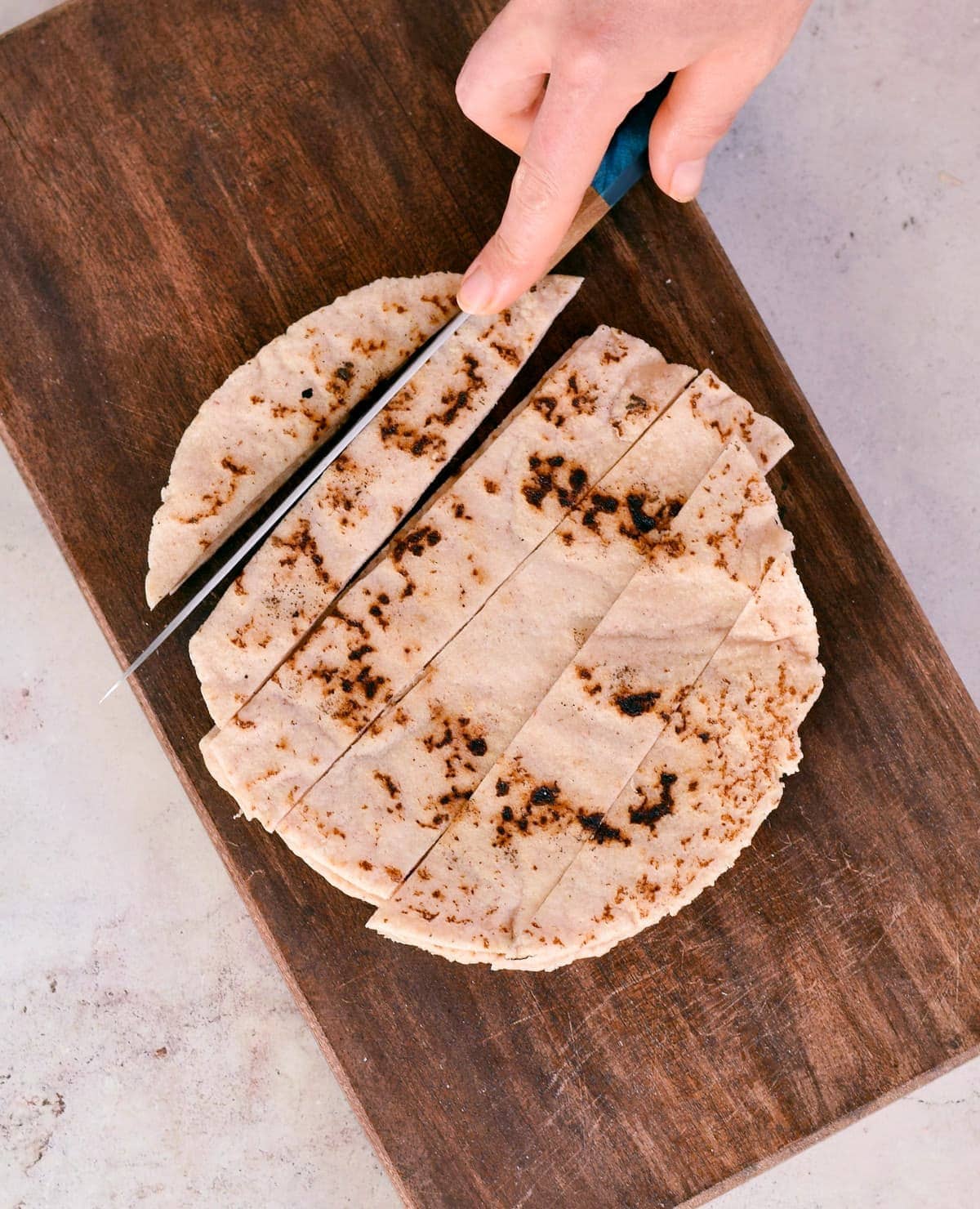
- Spread the pieces in a single layer over a baking sheet and bake for 7-10 minutes, or until crispy and browned. Alternatively, heat 2-3 tbsp of oil in a large skillet and pan-fry the pita bread until browned and crisp—season with a bit of salt, pepper, and sumac.
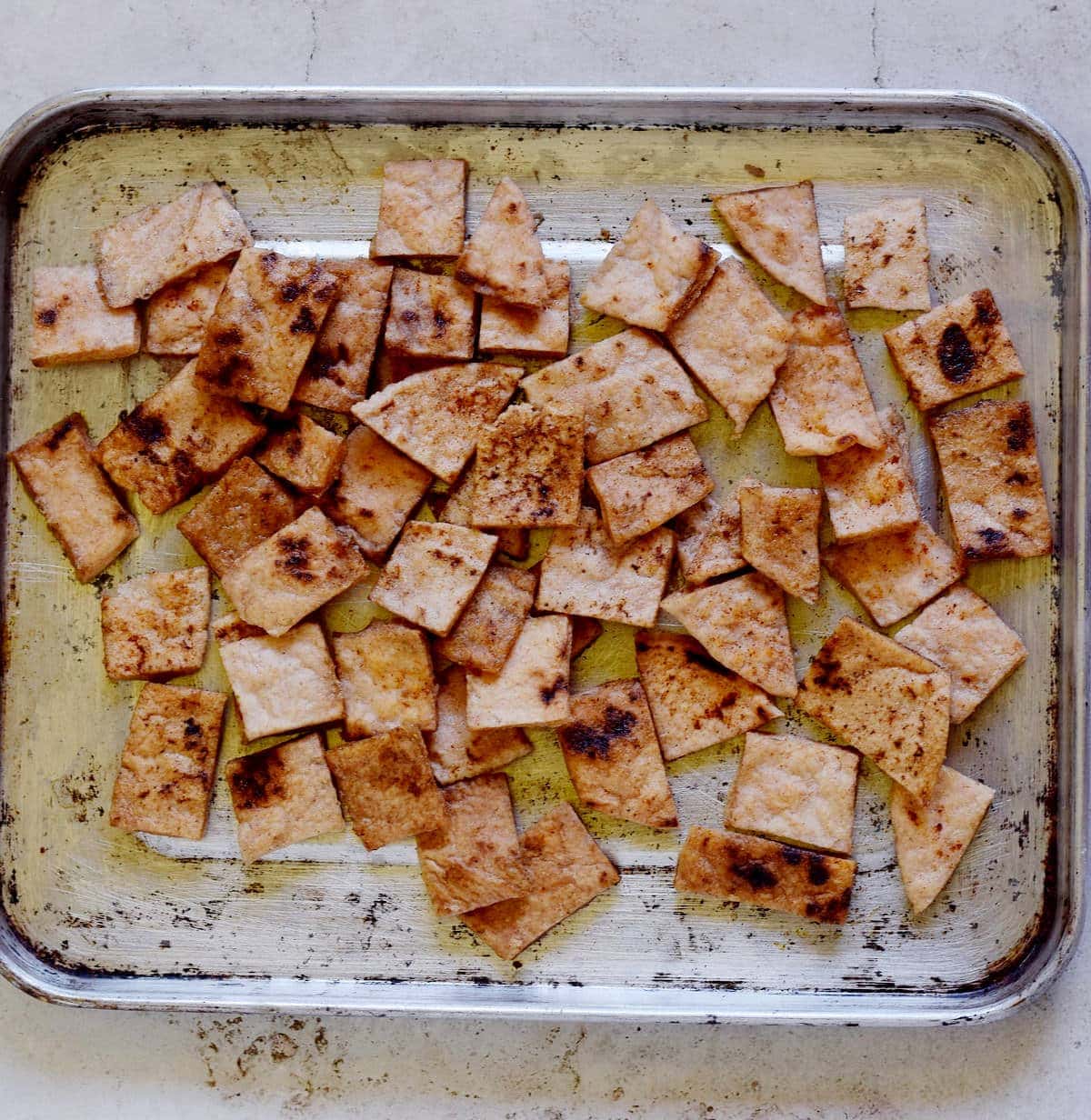
- Meanwhile, combine all the remaining salad ingredients in a large bowl; lettuce, tomatoes, cucumber, radish, green onion, parsley, and mint.
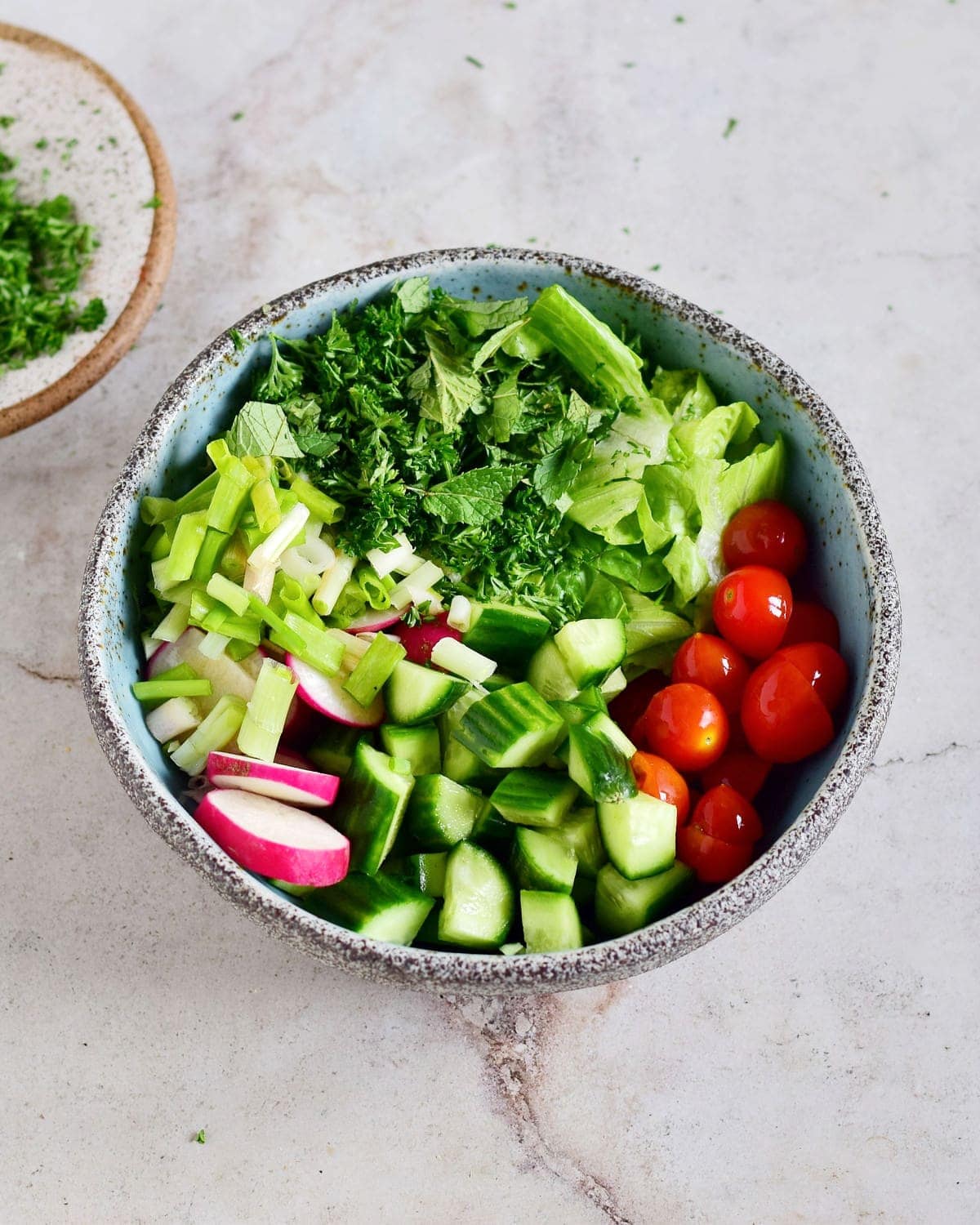
- To prepare the dressing, simply add all the ingredients to a small bowl and use a spoon or whisk to combine.
You could, alternatively, use a small food processor/blender to emulsify the fattoush dressing even better.
- Finally, pour the dressing over the salad, add the pita chips, and toss. Adjust any of the seasonings to your taste and then serve and enjoy!
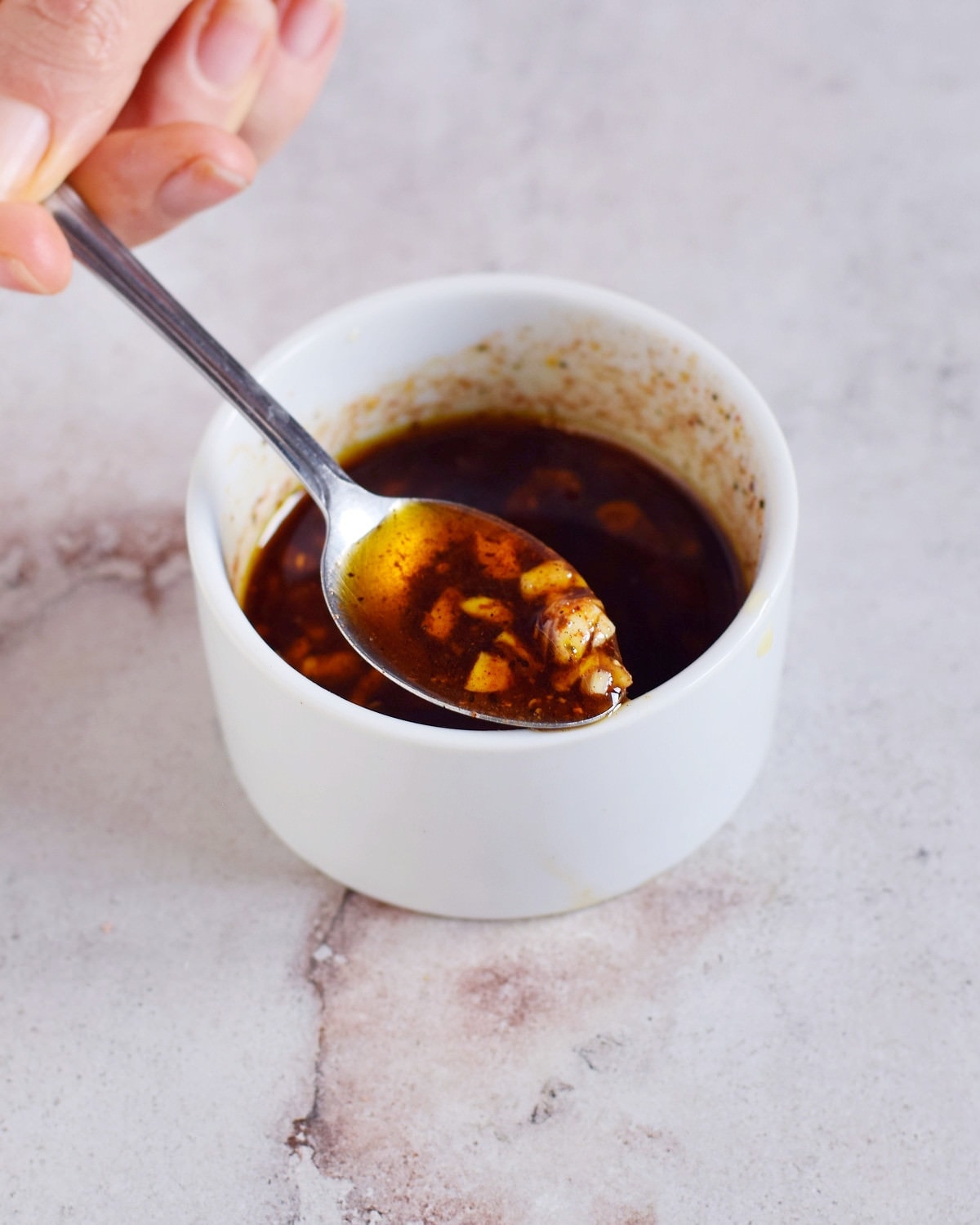
How to Make Ahead and Store?
To make ahead: You can prepare this fattoush salad, dressing, and the baked pita ahead for several days (3-4) and store it separately until serving. Don’t combine the pita and dressing with the salad in advance.
To Store: Once combined, it’s best to enjoy the salad immediately, or else the pita will go soggy. You can avoid this by serving the pita in a separate dish and storing the dressed salad for 2-3 days.
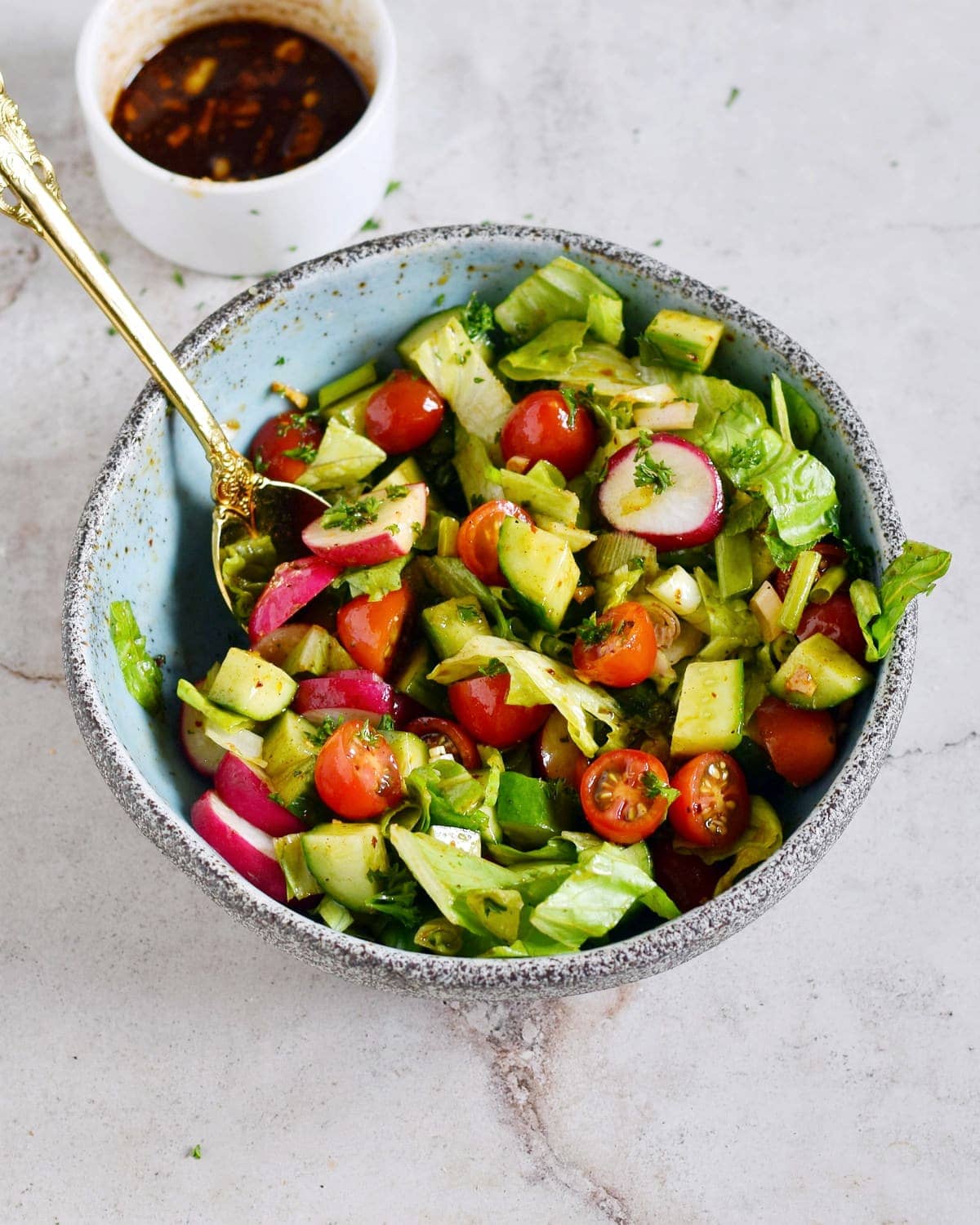
FAQs
What is sumac, and can I substitute it?
Sumac is a spice made from ground sumac berries with a tart flavor and dark, pinkish color. It should be available in most grocery stores. It’s quite hard to substitute due to its unique taste. A little lemon zest could work (though it will be more bitter). If you absolutely can’t find it, then simply omit it.
How do you serve fattoush?
Though you can serve this Lebanese salad alone for a light lunch/dinner, you can also serve it alongside the protein of your choice. Tofu vegetable kebabs, for example, could taste amazing alongside this salad. Small roasted potatoes or cauliflower could also help to bulk up the salad into more of a meal.
What else can I add to fattoush salad?
When it comes to this fattoush recipe, I’ve tried several variations with excellent results. Add olives, bell pepper, red/white onion, carrots, etc. You could add crispy roasted chickpeas for extra crunch (and protein) alongside the pita and experiment with different herbs. For more of a meal, feel free to add something like bulgur wheat or quinoa. You could also add your protein of choice or something like homemade falafel.
I’ll often also serve it alongside other Middle Eastern dips/sides like homemade hummus.
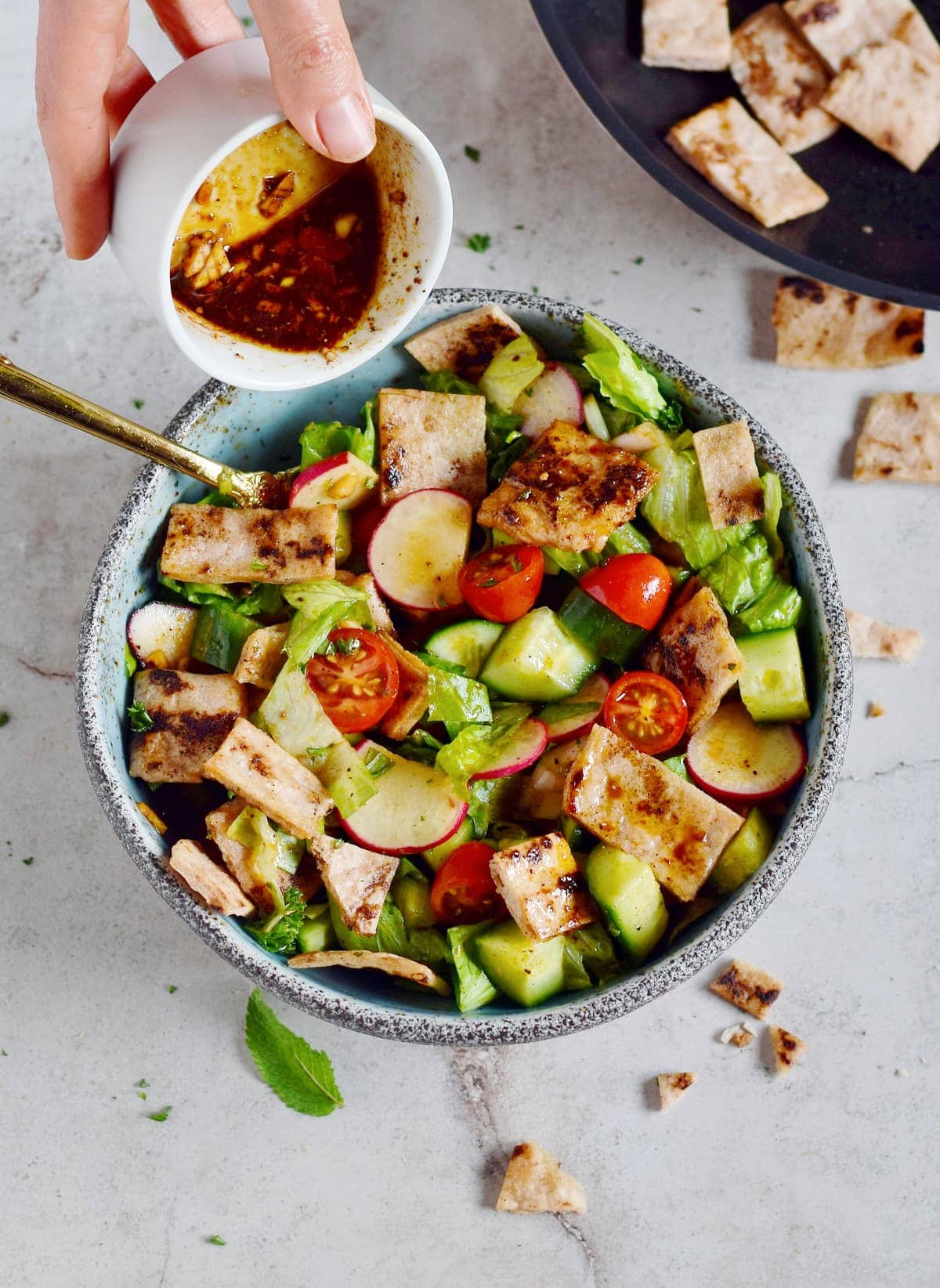
Recipe Notes
- Feel free to adapt the fattoush recipe: There is a lot of space to adapt with this simple Lebanese salad. Feel free to add different vegetables or substitute some that I’ve included (suggestions above). You can also use this recipe to clear out your fridge (like how I do for cooked veggies with veggie lo mein).
- If you think you’ll be saving any leftovers, then it’s a good idea to serve the salad with the pita chips on the side. That way, there’s no risk of them becoming soggy.
- The size of the veggies: How big you slice the various veggies is up to you based on how chunky you want the salad to be.
- Use high-quality, fresh ingredients: This salad is really simple and contains just a few, fresh ingredients which means it’s important to use the highest quality ingredients you can for the best results.
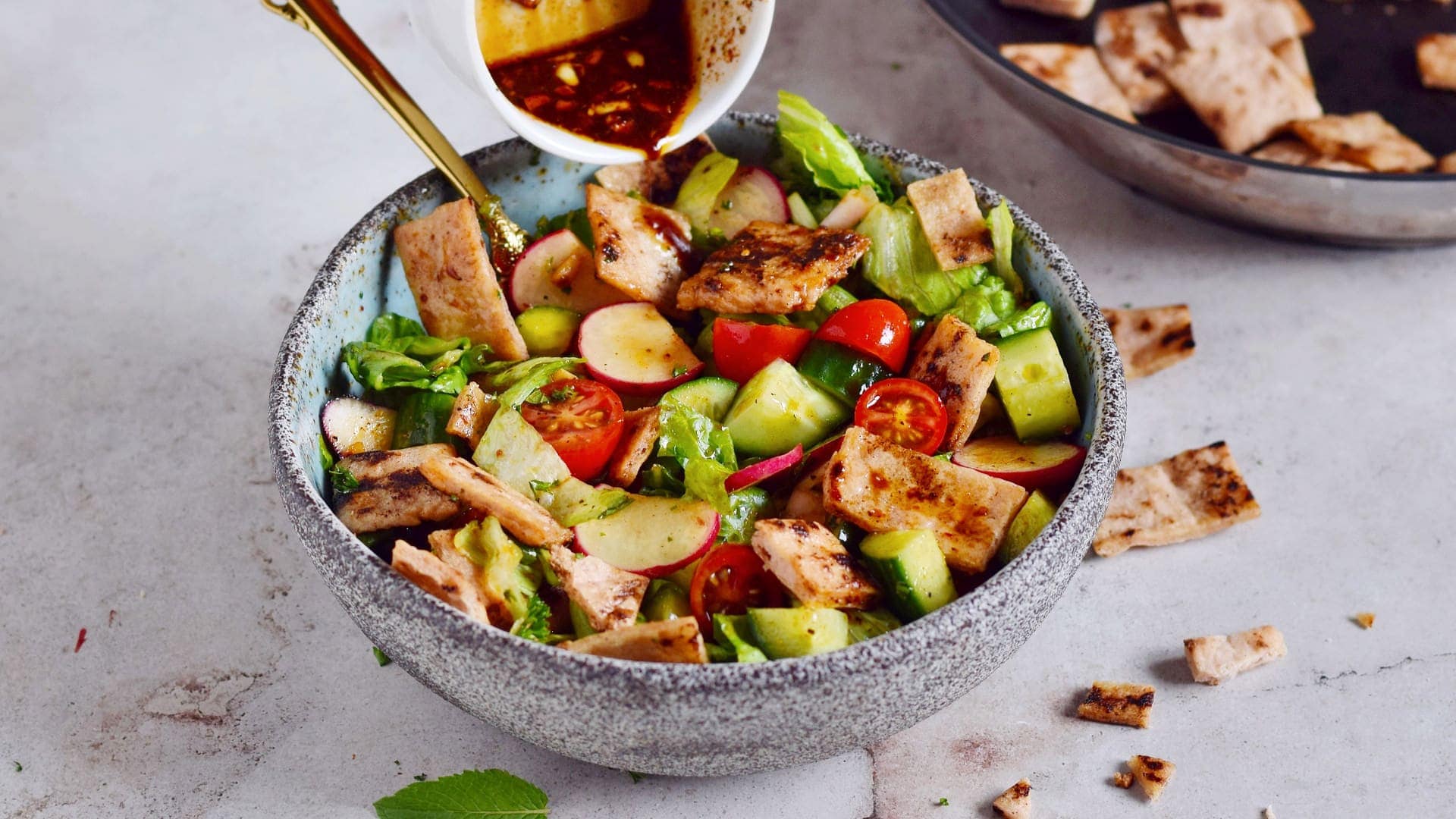
More Healthy Meat-Free Salads
- Vegan Chickpea Buddha Bowl
- Brown Rice Salad Bowl
- Mexican Avocado Salad
- Creamy German Cucumber Salad
- Healthy Oil-Free Pasta Salad
- Hasselback Potato Salad Bowl
If you try this fattoush recipe, I’d love a comment and ★★★★★ recipe rating below. Also, please don’t forget to tag me in re-creations on Instagram or Facebook with @elavegan #elavegan – I love seeing them.
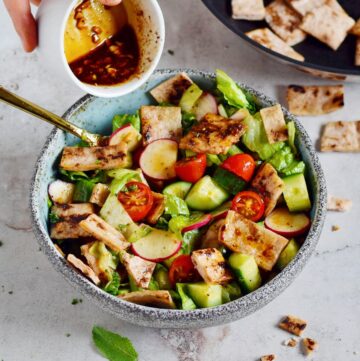
Fattoush Salad
Ingredients
Salad:
- 2 medium pita breads I used homemade gluten-free pita
- 1 large head Romaine lettuce chopped
- 1 handful of cherry tomatoes halved
- 2 Persian cucumbers chopped
- 4-5 radishes sliced
- 2-3 green onions chopped
- 1/2-1 cup fresh parsley chopped
- 1/4 cup fresh mint chopped
Dressing:
- 2 1/2 tbsp olive oil
- 2 tbsp fresh lemon juice
- 2 cloves of garlic minced
- 1 - 1 1/2 tsp pomegranate molasses
- 1/2 tsp sea salt
- 1/2-1 tsp ground sumac more to taste
- Black Pepper to taste
Instructions
- You can watch the video in the post for visual instructions.Preheat the oven to 390 degrees Fahrenheit (200 degrees Celsius).
- Chop the pita breads into bite-size pieces. Brush them with oil or add them to a bowl and drizzle with a little oil, then toss. Spread on a baking sheet and bake in the oven for about 7-10 minutes or until crispy. Alternatively, you can heat 2-3 tablespoons of oil in a skillet and fry the pita bread until browned. Season with a little salt, pepper, and sumac.
- Combine all remaining salad ingredients (Romaine lettuce, cherry tomatoes, cucumbers, radishes, green onions, parsley, and mint) in a large bowl.
- For the dressing, simply add all dressing ingredients to a small bowl and use a spoon or whisk to combine.
- Pour the dressing over the salad, add the pita chips and toss. Adjust the seasonings to your taste, serve and enjoy!
Notes
- Pomegranate molasses: It adds a lovely flavor. You can use a little balsamic vinegar or regular molasses instead, though the taste will differ.
- Salad veggies: You can add more or other veggies of choice if you prefer.
Nutrition information is an estimate and has been calculated automatically
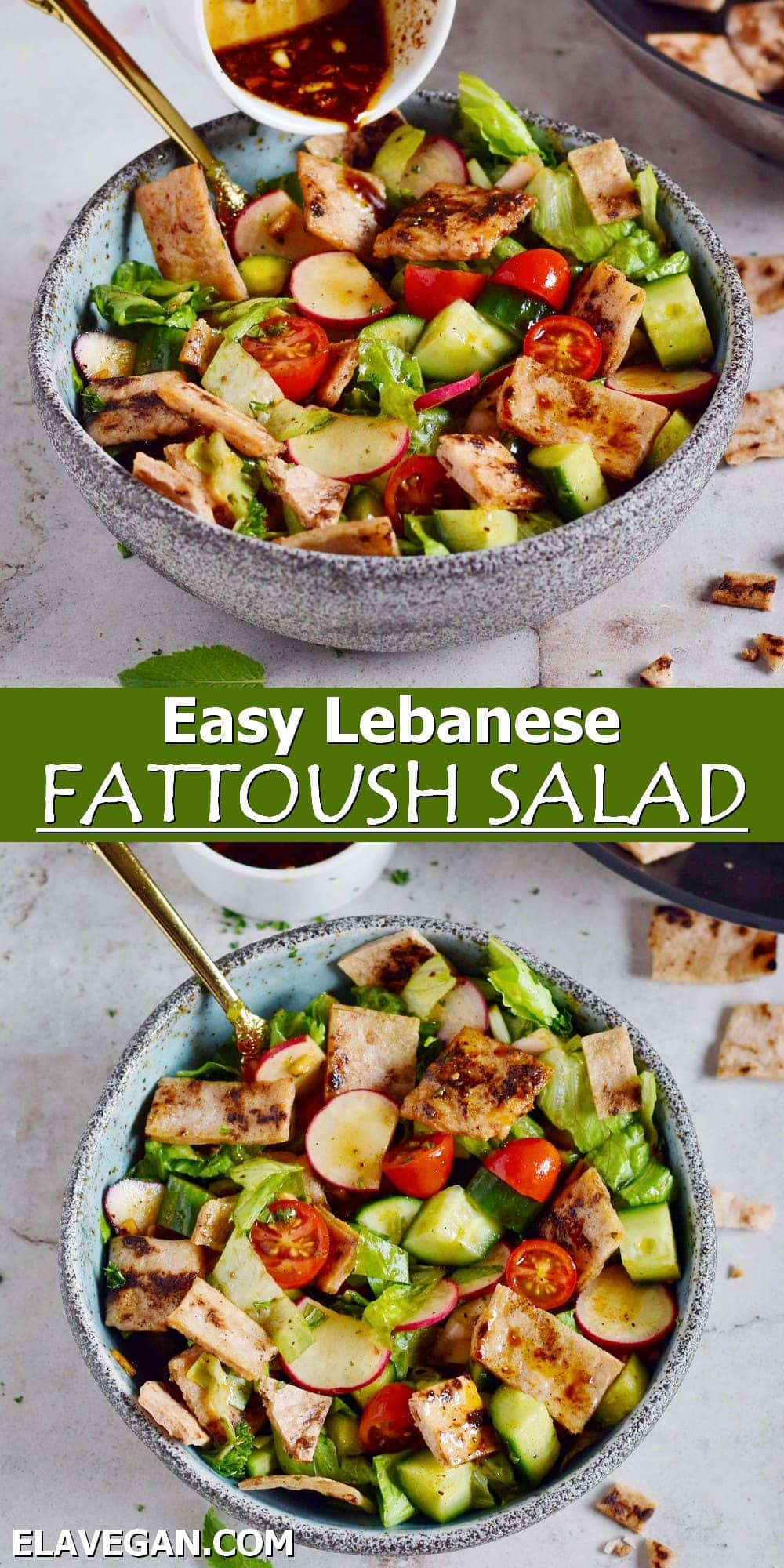

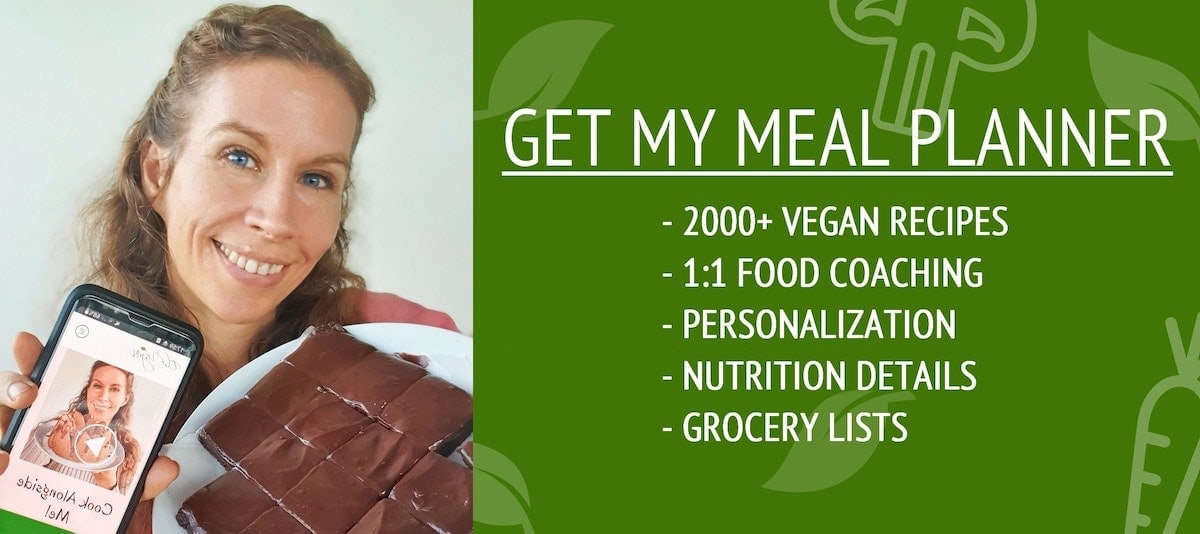

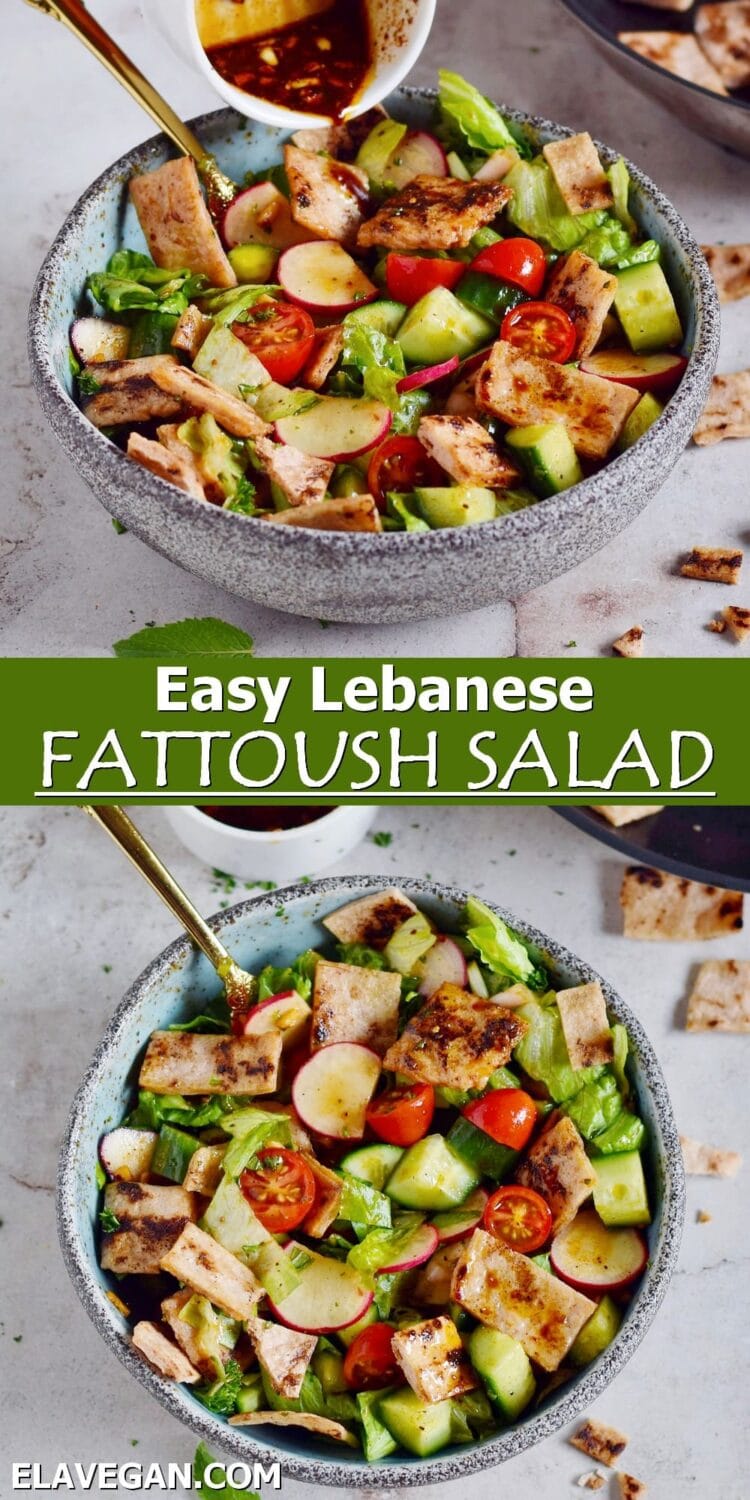
This is sooooo good! I went through the trouble of visiting a Middle Eastern grocery store just to buy the sumac and pomegranate molasses. Also discovered other new food items while I was there, this was a fun outing! Middle Eastern food is so full of flavor! Thanks for posting : )
You are very welcome, Christine! I am so glad you liked it and had fun discovering new food items. 🙂